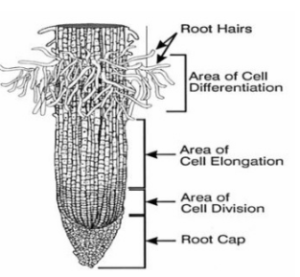Along with the germination of seeds, root development continues. Vascular plants have an underground structure called roots. Roots provide support to plants and offer means of absorption of nutrients and other supplements and help in the growth of plants.
Cells are formed by repeated cell divisions. Root elongation leads to the expansion of new cells that are constantly being formed with the help of cell division in the apical meristem region. The differentiation of these cells of the root leads to the formation of complex structures and tissue systems.
Region of elongation
What does the region of elongation mean? The root system is divided into four regions— root cap zone, region of cell division, elongation region, and region of maturation. The root cap region and active cell region are confined to 1 cm, while the elongation and maturation zone are at around 4-5 cm from the root tip. No more expansion and development take place once the root is elongated and matured.
The four regions of the root tip are as follows.
1.The root cap region – This region of root helps in covering the root at the apex region. It is a thimble-like structure or cupped structure made of parenchyma cells and protects the root. A lot of new cells are formed that change the worn-out cells and push the root tip into the soil. The slimy substance known as mucigel produced by root cap cells and epidermis helps in this process. In some plants, root caps can be seen, but in some, they are invisible. The functions of the root cap are:
Providing protection to the fragile root tip
Helping attract helpful microbes
Forming a slimy layer which helps with lubrication to move the root through the soil
Preventing drying of the root.
2.Region of cell division – The next nearby zone from which the root cap arises is the cell division region. This inverted cup-shaped region has an apical meristem at the edge. This region is actively divided with meristematic activity. The cells are cube-shaped, with large nuclei and small vacuoles. Three meristematic regions are developed known as protoderm, ground meristem and procambium. Protoderm develops into endoderm, ground tissue develops parenchyma cells of cortex, and procambium gives rise to primary xylem and phloem. There is a grey area present between an area of active cell division and the root cap where cell division is slower. This is known as the quiescent centre.
3. Elongation region – What does the region of elongation mean? The cells in this region become wider and increase in length. Small vacuoles combine or merge into one another and become larger. No variation in cell size is seen above this region and the elongated area of the root remains stationary throughout its life span. In the elongation zone, cells elongate rapidly and undergo a final round of divisions to develop a central ring of cells known as endodermis. Endodermis gives rise to two regions—the cortex toward the outside and the stele towards the inside. The region proximal to the region of elongation is the maturation zone.
4. Maturation region – In this region, the cells differentiate and give rise to primary tissues. This zone is called the root hair zone. Root hair first appears in the maturation zone. It can be easily recognized as it extends throughout the soil as an outgrowth from a single cell of the epidermis.
The primary tissues of the root are the epidermis, the cortex and vascular cylinder. The epidermis is the outermost layer, the cortex is in the middle, and the vascular cylinder is the innermost. The epidermis has thin-walled cells and is one cell layer thick. This region absorbs water and minerals.
·The cortex helps in the conduction of water and dissolved minerals from the epidermis to the vascular cylinder across the root, from where it is transported to the whole plant.
· The innermost layer is the endodermis, which helps in the regulation of water and minerals between the cortex and vascular tissues.
·The interior structure of the endodermis is the vascular cylinder surrounded by a pericycle.

Conclusion
Root growth arises as soon as the seed germinates. The embryo develops from the seed; the radicle part gives rise to the root system of the plant. The root tip is protected from the root cap, and this root cap is unique to plants. It also has a grey-coloured region known as the quiescent centre. The developing root has three zones of development—meristematic zone, elongation zone and maturation zone. Apart from these three zones, the root cap region is also present.
 Profile
Profile Settings
Settings Refer your friends
Refer your friends Sign out
Sign out






